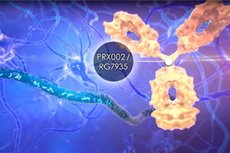Monoclonal antibody Prasinezumab slows progression of Parkinson's disease
Sist anmeldt: 14.06.2024

Alt iLive-innhold blir gjennomgått med medisin eller faktisk kontrollert for å sikre så mye faktuell nøyaktighet som mulig.
Vi har strenge retningslinjer for innkjøp og kun kobling til anerkjente medieområder, akademiske forskningsinstitusjoner og, når det er mulig, medisinsk peer-evaluerte studier. Merk at tallene i parenteser ([1], [2], etc.) er klikkbare koblinger til disse studiene.
Hvis du føler at noe av innholdet vårt er unøyaktig, utdatert eller ellers tvilsomt, velg det og trykk Ctrl + Enter.

In a recent study published in Nature Medicine, a large international team of researchers conducted an exploratory analysis to evaluate whether the monoclonal antibody prasinezumab, which previously has been found effective in slowing the progression of motor signs of Parkinson's disease, showing benefit in subgroups of Parkinson's disease patients with more rapid progression of motor degeneration.
One of the main hallmarks of Parkinson's disease is the aggregation of α-synuclein, which is thought to spread between neurons and contribute to pathogenesis Parkinson's disease. One of the first therapeutic options to target aggregated α-synuclein was the monoclonal antibody prasinezumab, which was investigated in a phase 2 clinical trial among patients with early-stage Parkinson's disease in the PASADENA trial.
The primary efficacy outcome measure in the phase 2 PASADENA trial was the Movement Disorder Society Unified Parkinson's Disease Rating Scale, or MDS-UPDRS.
In this study, the team examined the effect of prasinezumab in slowing the progression of motor degeneration in subgroups of patients with Parkinson's disease in whom the disease progressed rapidly. Given that MDS-UPDRS subscales may not show short-term treatment-related changes, monitoring subgroups with rapidly progressing Parkinson's disease may help improve the signal-to-noise ratio and identify potential monoclonal antibody effects.
The PASADENA study included three treatments—placebo, prasinezumab 1500 mg, and prasinezumab 4500 mg. Patients were randomly assigned to three groups after stratifying by age (over or under 60 years), sex, and use of monoamine oxidase B inhibitors. Patients using other symptomatic medications for Parkinson's disease, such as dopamine agonists or levodopa at baseline, were excluded. In cases where the use of these medications was considered necessary, MDS-UPDRS scores were calculated before treatment.
The results showed that prasinezumab was more effective in slowing the progression of motor symptoms in patients with Parkinson's disease, whose disease progresses rapidly. Subpopulation analyzes showed that patients with diffuse malignant phenotypes or those with initial use of monoamine oxidase B inhibitors, an indicator of rapid disease progression, showed slower worsening of motor degeneration compared with patients with phenotypes not indicative of rapid progression of Parkinson's disease.
The MDS-UPDRS Part III score, corresponding to physician-rated motor signs, showed slower worsening or increase in degeneration in patients treated with prasinezumab compared with those receiving placebo. Parts I and II of the MDS-UPDRS correspond to patient-reported motor and non-motor features, respectively.
Overall, the results suggest that the monoclonal antibody prasinezumab could potentially be used to slow the progression of motor degeneration in patients with a rapidly progressing form of Parkinson's disease. In addition, longer follow-up periods are required to evaluate the impact of prasinezumab treatment in patients with slowly progressive disease. Moreover, additional randomized clinical trials are needed to further confirm these results.
